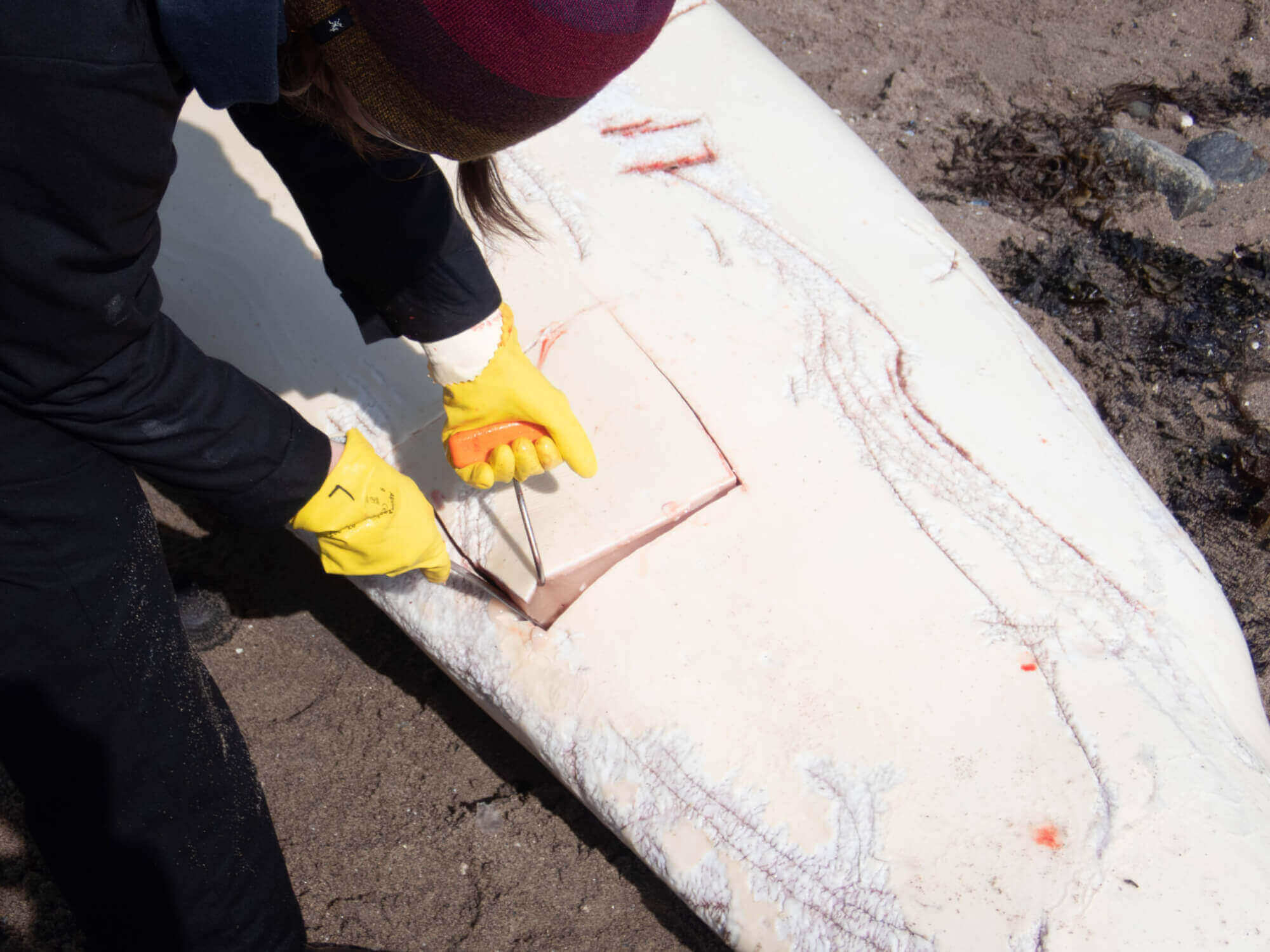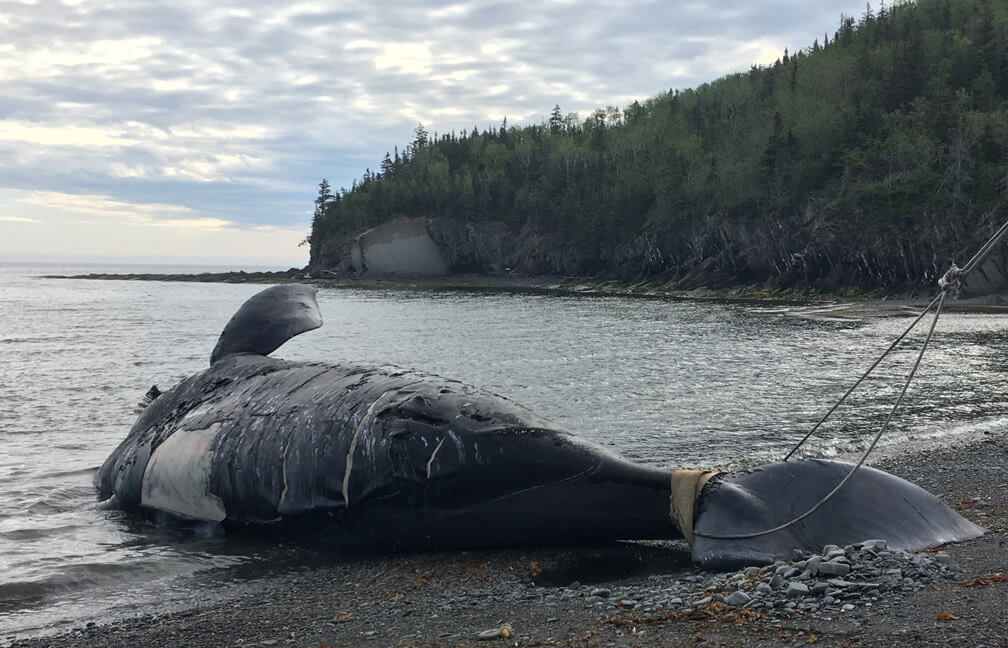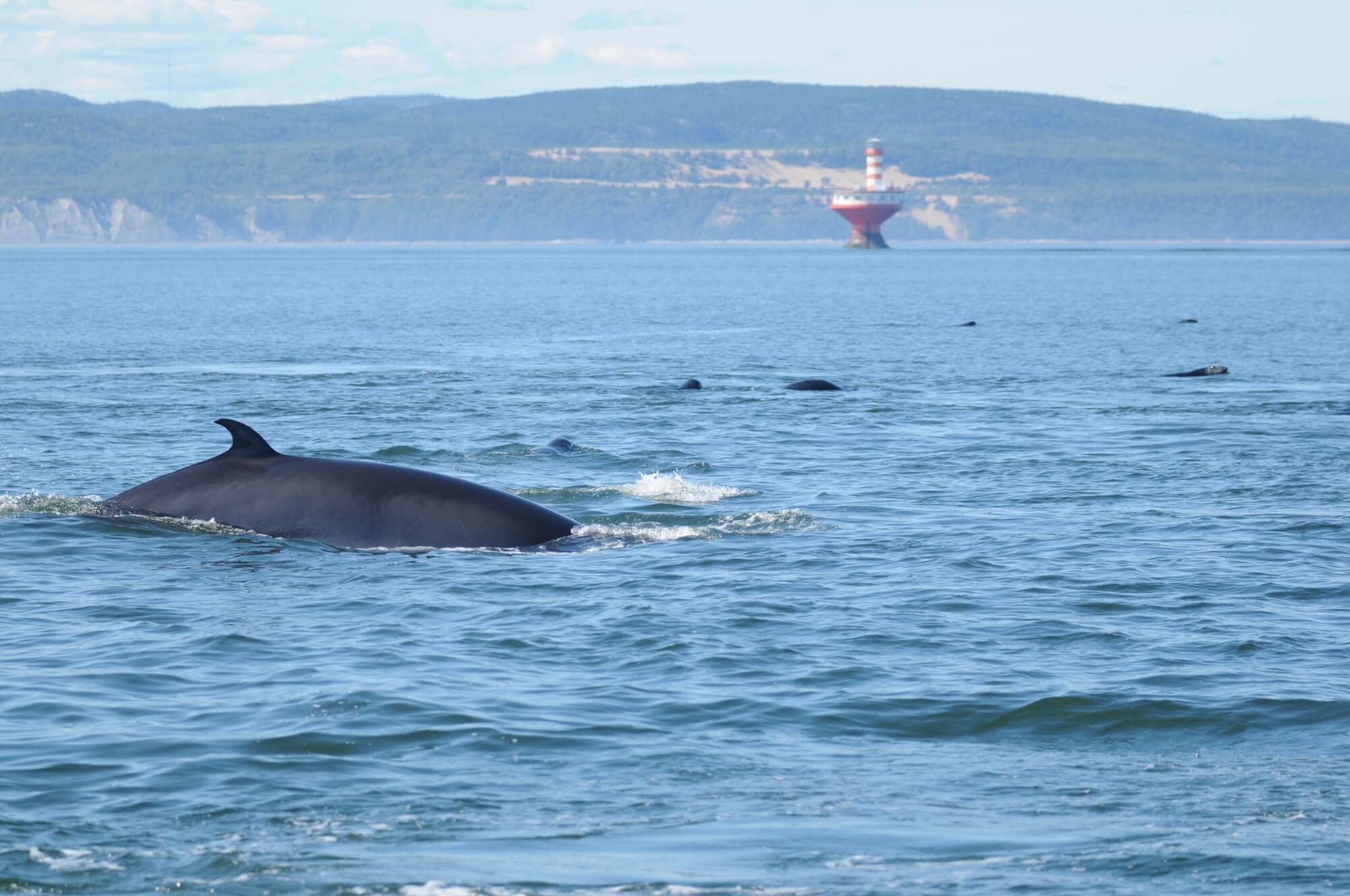When a marine mammal carcass is found stranded or adrift in the waters of the St. Lawrence, the Quebec Marine Mammal Emergency Response Network (QMMERN) has a clear and precise mandate: collect samples. Teeth, baleen, blubber, muscle and sometimes even certain organs… each of these samples contains a wealth of secrets and information. They are gold mines for research teams, who rely on sampling to determine the cause of the animal’s death, its age, what it ate, the presence of contaminants and even its life history.
To better understand the importance, usefulness and future of these samples, Whales Online met with Jory Cabrol, researcher at the Maurice Lamontagne Institute (MLI; administered by Fisheries and Oceans Canada, DFO). An expert in feeding behaviour ecology, Dr. Cabrol is currently working on the St. Lawrence beluga population as well as various species of large rorquals.
First responders
The Maurice Lamontagne Institute in Mont-Joli is one of the partners that processes the samples taken by the QMMERN. In the laboratories of this research centre, DFO scientists (including Jory Cabrol) use these samples to better understand the role and impact of the various environmental and human factors likely to affect marine mammal populations in the Estuary and Gulf of St. Lawrence. “This knowledge will be directly used to improve the harmonious cohabitation between humans and animals, but above all to help reduce the threats and other nuisances facing these oftentimes threatened populations,” explains the researcher. In a constantly changing world, it is important to understand how cetacean populations are evolving, as they play an essential role in the marine ecosystems that they call home.
But before ending up at the Maurice Lamontagne Institute, the samples were first taken in the field by members of the QMMERN. These field technicians have a fundamental role as first responders. One of their tasks is to collect general information about the animal, such as the species, sex, measurements, colour and state of decomposition of the carcass, presence of injuries, as well as more general information such as the coordinates of the stranding site. Everything is noted and listed by the QMMERN-managed Marine Mammal Emergencies unit, which compiles all of this information in a database.
Mobile teams and specially trained QMMERN volunteers will then be in charge of removing various parts of the animal for scientific purposes. When necessary, their mission consists of collecting samples of skin, fat and muscle, or the occasional tooth or baleen. On the other hand, each species has its own particularities in terms of sampling, so it is important to have a good understanding of the protocols and the needs for each of them. When the carcass is deemed fresh enough and it can be recovered, it may be sent intact to the Centre québécois sur la santé des animaux sauvages (Quebec wildlife health centre, CQSAS) in Saint-Hyacinthe for a necropsy. This is often the case with smaller carcasses such as belugas, as well as some harbour porpoises, seals and dolphins. Veterinarian Stéphane Lair and his team will then perform necropsies on the carcasses to determine the cause(s) of mortality.
If the state of decomposition of the carcass is too advanced and it is not a CQSAS target species, it is possible that, after being tagged, it is simply left behind for nature to take care of the rest.
Travelling back in time with baleen and teeth
Did you know that age of the individual can be estimated by examining its teeth? Much like in trees, teeth show one or two growth layers per year when sliced crosswise. Specialists can count these lines and determine the age of the toothed whale. For baleen whales, it is a little more complex. Age can be determined a number of different ways, for example by using baleen in the first years of life or wax plugs and the number of ovarian scars thereafter. Baleen, which is made up of layers of keratin, the same material found in our hair and nails, makes it possible to go back in time and study the ecology of the individual, explains Jory Cabrol.
As they are mainly composed of less active tissues that accumulate over time, baleen and teeth trap information that scientists can use to chronicle an individual’s past. The trophic ecology researcher explains that scientists can notably detect hormones, contaminants (including mercury), as well as other clues that can provide insight into the animal’s diet and migration behaviour. In this context, the mandibles and long baleen recovered by the QMMERN team are mainly used to reconstruct the individual’s life history.
Mysteries beneath the skin
We can also trace the presence of contaminants in the animal’s blubber. This layer of fat, which varies in thickness depending on the species, season and sex, is a place where a certain amount of contaminants can accumulate, explains Jory Cabrol. Through chemical analyses, scientists are therefore able to determine the kinds and intensity of substances that individuals have been exposed to. It will also potentially give clues to the state of the environment in which the whale lived, as well as the effects of such exposure such as tumours or a weakened immune system.
This blubber is also an essential source of information for monitoring populations, adds the MLI researcher. Indeed, the level of progesterone, a sex hormone produced in large quantities during pregnancy, can be established using a technique known as dosing. It is thus possible to determine whether or not females have recently gestated. Pregnancy rates are a crucial parameter for monitoring populations, in particular for estimating the number of individuals.
It is also possible to use the animal’s energy-storing blubber as an indicator of its physical condition and diet.Concentrations of this element’s two main components, lipids and fatty acids, can be used to see if the animal’s energy needs were satisfied. The composition of fatty acids also helps determine the individual’s diet during the weeks preceding the sampling.
As for the skin, it can also be used to characterize the diet of an individual, much like blubber. However, as it regenerates more slowly than blubber, it tends to contain information over a longer window of time (several weeks to a few months). Scientists are particularly interested in the stable isotopes found in the skin in order to determine, amongst other things, what kinds of prey the animal has consumed and in what quantity. These isotopes are different forms of the same carbon, oxygen, sulphur or even nitrogen atom. Based on these isotopes, it is possible to know whether the marine mammal in question had a rather specialized diet, i.e. fed on a limited number of prey, or a more generalist diet, explains Jory Cabrol. The skin can also be used to determine the sex of the individual and even to identify it genetically, much like a fingerprint.
As for the muscles under this massive layer of skin and blubber, the biologist explains that a range of analyses may be carried out such as those mentioned above. On the other hand, it is essentially the contaminants, the various stable isotopes and the presence of parasites in this part of the animal that are of interest to scientists.
What about the rest of the carcass?
The MLI specialist in cetacean trophic ecology mentions that the liver, the heart and even the brain may also be relevant for certain research projects. As a filtering organ, the liver can accumulate certain contaminants or compounds that are less present in other organs. Depending on the research being conducted, the brain and heart can also be used to detect the concentration of certain contaminants as well as the presence of parasites. For example, Jory Cabrol is currently working in collaboration with the Faculty of Veterinary Medicine in Saint-Hyacinthe to determine the concentrations of toxoplasmosis, a parasite notably found in various organs of domestic cats.
Advancing marine mammal research
Given the constant progress in science and technology in recent years, research on these giants of the seas is expected to progress rapidly. This is why the samples sent to the MLI are archived for later use for temporal studies, as well as for other types of analyses as new technologies become available.
Scientists are increasingly able to understand how marine mammal populations in the Estuary and Gulf of St. Lawrence are evolving and whether they are managing to hold their own. Given their essential role in ecosystems, it is critical to understand how these cetaceans are adapting to the changing environment in which we live. “You have to look at nature as a whole. The more quality information you have, the better you can understand and appreciate it, but above all protect our environment,” concludes the researcher.
If you see a dead or struggling marine mammal, do not attempt to intervene. Promptly contact Marine Mammal Emergencies at 1-877-722-5346. A team will travel to the scene and take stock of the situation.












